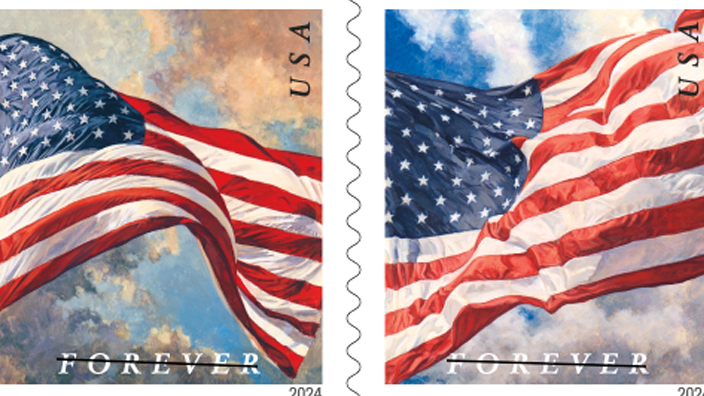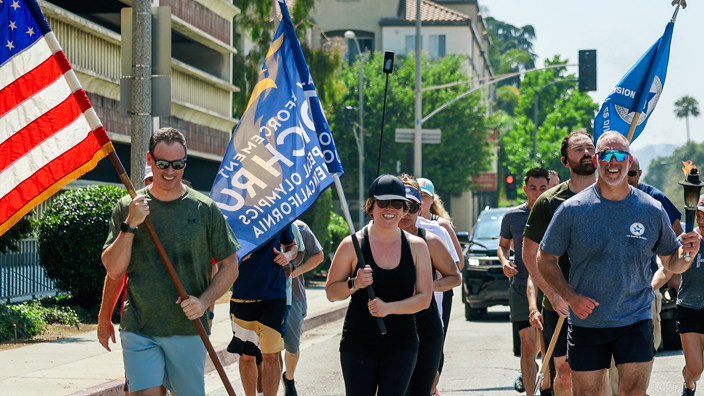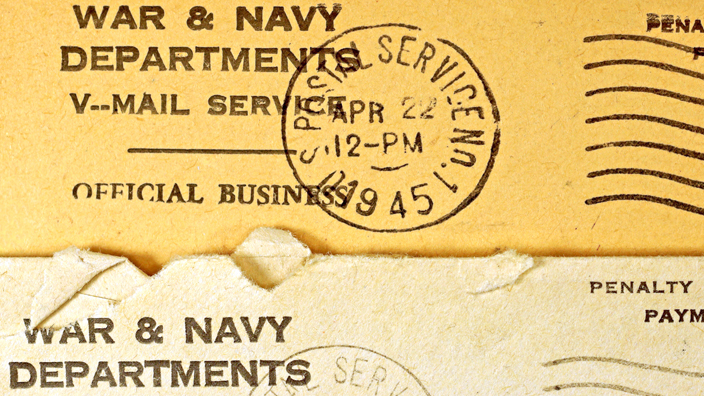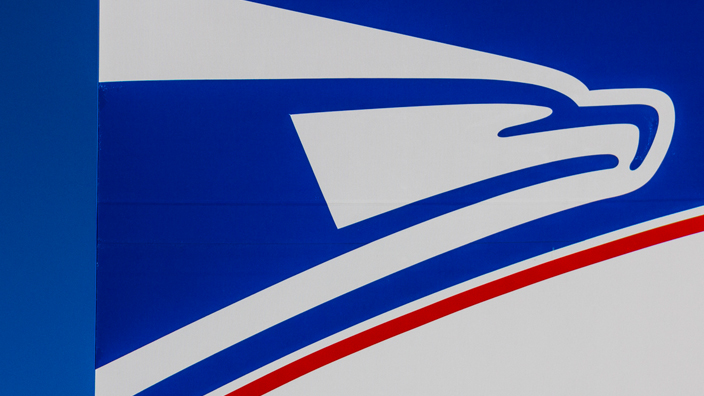
USPS to let new stamps fly on Flag Day
The set of four images pairs Old Glory with sunshine
U.S. Flags, the Postal Service’s latest set of stamps celebrating the Stars and Stripes, will be released on Friday, June 14 — Flag Day.
The four designs depict Old Glory majestically waving at different times of day. In each image, the sun is shining on the flag.
Ethel Kessler, an art director for USPS, designed the stamps with illustrations by Laura Stutzman.
The U.S. Flags stamps will be available in books of 20 and coils of 100, 3,000 and 10,000 at Post Offices and usps.com.

Carrying the torch
Postal inspectors go the distance, a manager switches to Plan Bee and a Post Office does a safety check
A team representing the Postal Inspection Service’s Los Angeles division recently participated in an annual running event to support the Special Olympics.
Since 1981, the Law Enforcement Torch Run has raised awareness and money for Special Olympics athletes.
This year’s postal team of almost 30 runners — which included postal inspectors, Postal Police officers and others — ran in formation while carrying the torch for a relay leg of 2.5 miles.
“It’s healthy for us as an organization for team building, increasing morale and camaraderie, and providing a win for the public,” said Carroll Harris, the division’s inspector in charge.
Spectators along the Route 66 stretch of Colorado Boulevard, also the route of the New Year’s Day Rose Parade, watched and cheered on the runners in support of their cause.
“It feels good when we’re running by, and people see the torch and what it represents. They stop what they’re doing and clap,” Harris said.
Bee prepared
Mike Smith, a distribution operations manager at the Lexington, KY, Processing and Distribution Center, received a call from the dock on a recent Sunday telling him a truck arrived with its contents improperly secured.
The contents? Bees. Lots of bees.
Rather than run for the hills, Smith contacted an apiarist acquaintance for advice and was told to move the truck to a dark place to get the bees to settle down.
With the help of the center’s maintenance team, he fashioned a makeshift beekeeping suit using coveralls, gloves and a safety mask and proceeded to secure the scary load.
Not a single sting was reported.
Now that’s putting hive mind to good use.
Checkpoint
Some letter carriers were recently stopped on the road by authorities — but the only citations issued were tips on staying safe.
The Frankfort, KY, Post Office held a “safety roadblocks” observation session to ensure that carriers are employing best practices while behind the wheel.
Sessions like these are common at postal facilities, part of the organization’s emphasis on employee safety.
“We checked for seatbelt use, headlights and the use of their blinkers,” said Alicia Boniface, a customer services supervisor.
“We stopped them to either discuss any improvements we observed or thank them for a job well done.”
“People” appears regularly in Link. Got news to share? Email us.

The patriotic way to post during WWII
V-Mail was launched June 15, 1942
Isn’t traveling light always the best way to go?
During World War II, real estate on flights overseas was at a premium. The sacks of letters that went back and forth between troops and the homefront took up space that was needed for war supplies.
The powers that be knew how important for morale these letters were, however. A letter from home “strengthens fortitude, enlivens patriotism [and] makes loneliness endurable,” as a 1942 report put it.
To solve the dilemma, the United States took a page from Airgraph Ltd., which the British Post Office launched in partnership with Kodak in 1941. The United States called its version Victory Mail, or V-Mail.
With a few slight changes, the services were the same: A special stationery form was used for the letter, which was then photographed onto microfilm. The microfilm was flown overseas and printed out on another form, which was delivered to the recipient.
V-Mail was launched on June 15, 1942, and ran through April 1, 1945. In that time, more than a billion letters were sent using the process.
There were limitations, to be sure. To save paper, the final letter that was delivered was a quarter to half the size of the original. Some stores sold special V-Mail magnifying glasses.
Troops’ letters were censored to ensure that no strategic information was leaked.
No enclosures were permitted, and even a lipstick kiss on a V-Mail form — known as the “Scarlet Scourge” — would gum up the works.
Still, while most letters were still sent the usual way, it has been estimated that V-Mail freed up almost 98 percent of the weight and space that the equivalent paper letters would have taken up.
Writing in Naval History Magazine, Thomas Wildenberg noted that collectors are growing interested in V-Mail letters.
“These wonderful mementos of a bygone era help us understand the past while preserving the memory of those who served in World War II.”
The “History” column appears occasionally in Link.

Loss leader
Check your recall of these recent stories
“News Quiz” is a weekly feature that lets you test your knowledge of recent Link stories. The correct answers appear at the end.
1. Fill in the blank: The Delivering for America plan has reduced the Postal Service’s projected 10-year losses from $160 billion to (blank).
a) $65 billion
b) $75 billion
c) $85 billion
d) $95 billion
2. True or false: Under the Hatch Act, USPS employees are permitted to attend political fundraisers.
a) True
b) False
3. Where does Ellen Damin serve as postmaster?
a) Grand Teton National Park (Wyoming)
b) Denali National Park and Preserve (Alaska)
c) Yellowstone National Park (California)
d) Yosemite National Park (California)
4. How many USPS employees were attacked by dogs last year?
a) More than 5,300
b) More than 5,800
c) More than 6,300
d) More than 6,800
5. Which of the following are examples of insider threats?
a) Disclosing restricted information on the internet
b) Unauthorized use of USB devices
c) Unlawful retention of postal property
d) All of the above
Answers: 1) a. 2) a. 3) d. 4) b. 5) d.
Postal Bulletin spotlights the Postmaster General Heroes’ Program
Postal Bulletin’s latest edition, published June 13, takes a look at the Postmaster General Heroes’ Program, which honors employees who go above and beyond the call of duty.
Updates to the organization’s policies, procedures and forms are also included.
Employees can go to usps.com to read and download the latest Postal Bulletin, along with past issues.
View past printouts
Printout details
What's included
-

USPS to let new stamps fly on Flag Day
The set of four images pairs Old Glory with sunshine
-
 People
PeopleCarrying the torch
Postal inspectors go the distance, a manager switches to Plan Bee and a Post Office does a safety check
-
 History
HistoryThe patriotic way to post during WWII
V-Mail was launched June 15, 1942
-
 News Quiz
News QuizLoss leader
Check your recall of these recent stories
-
Brief
Postal Bulletin spotlights the Postmaster General Heroes’ Program